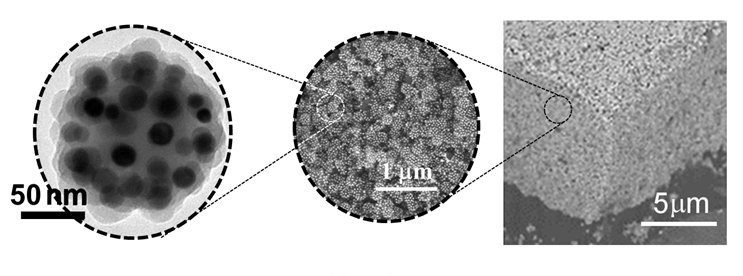The Metamaterials Group at CRPP, Bordeaux, have studied “plasmonic raspberries” produced by ICMCB colleagues, using a static light scattering set-up based on an NKT Photonics supercontinuum laser associated with a SuperK VARIA filter.
The measurements are based on the fact that a polarizable colloid presents an oscillating polarization upon illumination by a plane wave, which radiates in an anisotropic manner. The radiation diagram of a dipole is a torus with an axis of revolution parallel to the dipole moment. Therefore, in a light scattering experiment, if the incident polarization is rotated while the collection polarization is fixed, the signal scattered by an electric dipole varies as a sine squared function of the incident polarization angle. For these measurements, it is crucial to be able to access the scattered signal for different polarization configurations in a spectroscopic manner, in order to record the resonant behavior of the complex colloids.

The Metamaterials Group has used the visible range of wavelengths from the NKT Photonics SuperK and has resolved the beam spectrally with the SuperK Varia set to a 6nm-bandwidth. The measurements show that the raspberry-like nanoresonators present a strong magnetic Mie resonance, meaning that they react to light as if they were magnetized by the magnetic field of the light wave.
The plasmonic raspberries were then assembled, using microfluidic technology, into a compact material, which also reacts to illumination as if it were magnetized by the magnetic field of the light beam (in other terms, it has µ≠1), as was shown by spectroscopic ellipsometry in collaboration with a Manchester team. Controlling such a response, which does not exist in natural materials, is a powerful new route to monitor the refractive indices and therefore control the path of light in artificial materials.
Learn more about these studies in the recent publications of the Metamaterials Group at CRPP, Bordeaux:
Hierarchical self-assembly of a bulk metamaterial enables isotropic magnetic permeability at optical frequencies
S. Gomez-Graña, A. Le Beulze, M. Treguer-Delapierre, S. Mornet, E. Duguet, E. Grana, E. Cloutet, G. Hadziioannou, J. Leng, J.-B. Salmon, V. G. Kravets, A. N. Grigorenko, N. A. Peyyety, V. Ponsinet, P. Richetti, A. Baron, D. Torrent, P. Barois, Materials Horizons 3, 596-601 (2016), DOI: 10.1039/c6mh00270f
Self-Assembled Optical Metamaterials
A. Baron, A. Aradian, V. Ponsinet, P. Barois, J. Opt. & Laser Techn. 82, 94-100 (2016), DOI:10.1016/j.optlastec.2016.02.024
Isotropic 3D Optical Magnetism in Visible Light in a Self-Assembled Metamaterial
S. Gomez-Graña, M. Treguer-Delapierre, E. Duguet, J.B. Salmon, J. Leng, V. Kravets, A.N. Grigorenko, A. Peyyety, V. Ponsinet, P. Richetti, A. Baron, D. Torrent-Marti, P. Barois, IEEE Xplore, 2016, Article number 7746432, Pages 52-54, DOI: 10.1109/MetaMaterials.2016.7746432
Resonant isotropic optical magnetism of plasmonic nanoclusters in visible light
V. Ponsinet, P. Barois, S.M. Gali, P. Richetti, J.B. Salmon, A. Vallecchi, M. Albani, A. Le Beulze, S. Gomez-Grana, E. Duguet, S. Mornet and M. Treguer-Delapierre, Phys. Rev. B 92, 220414(R) (2015), DOI: 10.1103/PhysRevB.92.220414





